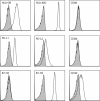Safety Profile of Good Manufacturing Practice Manufactured Interferon γ-Primed Mesenchymal Stem/Stromal Cells for Clinical Trials
- PMID: 28887912
- PMCID: PMC6430053
- DOI: 10.1002/sctm.16-0485
Safety Profile of Good Manufacturing Practice Manufactured Interferon γ-Primed Mesenchymal Stem/Stromal Cells for Clinical Trials
Abstract
Mesenchymal stem/stromal cells (MSCs) are widely studied by both academia and industry for a broad array of clinical indications. The collective body of data provides compelling evidence of the clinical safety of MSC therapy. However, generally accepted proof of therapeutic efficacy has not yet been reported. In an effort to generate a more effective therapeutic cell product, investigators are focused on modifying MSC processing protocols to enhance the intrinsic biologic activity. Here, we report a Good Manufacturing Practice-compliant two-step MSC manufacturing protocol to generate MSCs or interferon γ (IFNγ) primed MSCs which allows freshly expanded cells to be infused in patients on a predetermined schedule. This protocol eliminates the need to infuse cryopreserved, just thawed cells which may reduce the immune modulatory activity. Moreover, using (IFNγ) as a prototypic cytokine, we demonstrate the feasibility of priming the cells with any biologic agent. We then characterized MSCs and IFNγ primed MSCs prepared with our protocol, by karyotype, in vitro potential for malignant transformation, biodistribution, effect on engraftment of transplanted hematopoietic cells, and in vivo toxicity in immune deficient mice including a complete post-mortem examination. We found no evidence of toxicity attributable to the MSC or IFNγ primed MSCs. Our data suggest that the clinical risk of infusing MSCs or IFNγ primed MSCs produced by our two-step protocol is not greater than MSCs currently in practice. While actual proof of safety requires phase I clinical trials, our data support the use of either cell product in new clinical studies. Stem Cells Translational Medicine 2017;6:1868-1879.
Keywords: Good Manufacturing Practice (GMP); Interferon gamma; Mesenchymal stem cells; Mesenchymal stromal cells (MSC).
© 2017 The Authors Stem Cells Translational Medicine published by Wiley Periodicals, Inc. on behalf of AlphaMed Press.
Conflict of interest statement
Dr. White is a consultant for GenomeNext LLC. The other authors indicated no potential conflicts of interest.
Figures






References
-
- Squillaro T, Peluso G, Galderisi U. Clinical trials with mesenchymal stem cells: An update. Cell Transplant 2016;25:829–848. - PubMed
-
- Galipeau J. The mesenchymal stromal cells dilemma–does a negative phase III trial of random donor mesenchymal stromal cells in steroid‐resistant graft‐versus‐host disease represent a death knell or a bump in the road? Cytotherapy 2013;15:2–8. - PubMed
-
- Sivanathan KN, Gronthos S, Rojas‐Canales D et al. Interferon‐gamma modification of mesenchymal stem cells: Implications of autologous and allogeneic mesenchymal stem cell therapy in allotransplantation. Stem Cell Rev 2014;10:351–375. - PubMed
-
- Sivanathan KN, Rojas‐Canales DM, Hope CM et al. Interleukin‐17A‐induced human mesenchymal stem cells are superior modulators of immunological function. Stem Cells 2015;33:2850–2863. - PubMed
Publication types
MeSH terms
Substances
Grants and funding
LinkOut - more resources
Full Text Sources
Other Literature Sources
Medical

